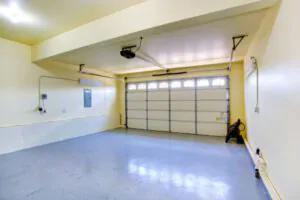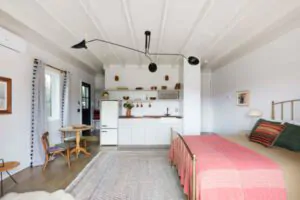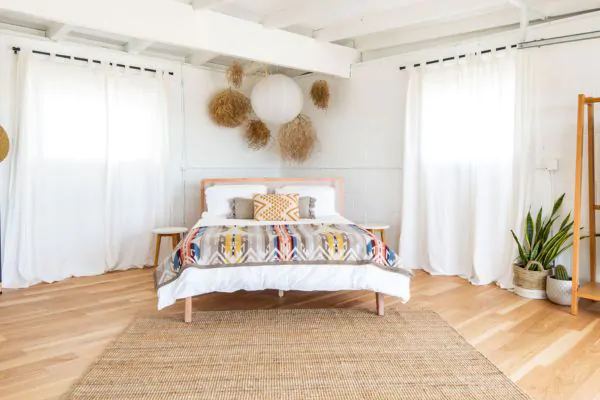Nestled within the boundaries of residential properties, garages present untapped potential that often goes unnoticed. Beyond housing vehicles and overflow clutter, these spaces harbor the capacity for transformation and convert a garage into a bedroom.
By reimagining the function of a garage, you can unlock additional living space and enhance the value of their abode. To unveil the full scope of a garage’s possible metamorphosis, continue on a guided exploration of the nuanced process involved. Keep reading to uncover the secrets behind effectively repurposing a garage, including planning, budget considerations, and the selection of the right professionals to bring a dream space to life.
The Overlooked Potential of Garages

Many homes boast a sizable garage, often regarded merely as a shelter for vehicles or a repository for miscellaneous household overflow. Beneath the surface, these spaces harbor immense potential, ripe for transformation. The optimal utilization of a garage holds the promise to significantly boost a property’s value as well as its owner’s lifestyle.
A garage’s metamorphosis may go down a few roads: a haven for hobbies, a fully equipped home gym, or even an ancillary dwelling unit. The space can undergo reinvention, reflecting the unique aspirations and requirements of the homeowner. Unearthing a garage’s latent function requires creativity and strategic planning.
- Identifying the main objective for the space
- Planning the layout to suit the intended purpose
- Allocating resources for renovation
- Executing the transformation with precision
Embarking on the transformation journey is exciting. It is crucial for you to approach the project with a steadfast commitment to the envisioned outcome. Integrating expert advice ensures that the renewed space not only meets but exceeds expectations, merging utility with aesthetic allure.
Unlocking Value: Converting a Garage into a Master Bedroom
A tranquil oasis for repose, the transformation of a garage into a master bedroom presents the opportunity to enhance one’s living quarters without the need to expand the home’s footprint. This endeavor not only recasts an underutilized area into a private suite but can significantly elevate the property’s market appeal.

The project begins with a thorough evaluation of the existing structure to ascertain its suitability for conversion: the foundations, walls, and roofing must be amenable to the modifications essential for a comfortable bedroom space. Beyond the structural integrity, considerations will include insulation, ventilation, and electrical wiring, aligning with residential building codes to ensure habitability is paramount.
- Assessment of the garage’s structural integrity
- Enhancement of insulation and ventilation
- Upgrading electrical systems to residential standards
- Achievement of compliance with building codes
Upon ensuring the garage’s foundational readiness, the focus shifts to interior design. Clever design choices can seamlessly transform utilitarian concrete and drywall into a warm and inviting bedroom. Every detail bears significance, from the selection of soothing color palettes to the installation of plush carpeting and customized lighting, all combining to forge an ambiance of serenity and comfort.
Once the transformation is complete, the new bedroom stands as a testament to ingenuity and resourceful planning. Not only does it provide the homeowners with a personal retreat, but it demonstrates the potential of garages to become integral parts of the home. Such foresight in optimizing existing spaces provides a compelling narrative for current and future occupants of the premises.
Navigating the Legal Terrain: Essential Steps in Garage Conversion
Embarking on a garage remodel demands meticulous attention to legal stipulations. As owners contemplate repurposing their garage space, securing the requisite permits such as garage conversion permit, remains non-negotiable. The process initiates with a visit to the local planning department, ensuring all intended modifications adhere to zoning laws and construction codes.
The approval journey entails submitting detailed architectural plans, highlighting the envisioned alterations. This transparency with local authorities not only expedites the permit acquisition process but safeguards the investment by adhering to the stringent criteria for residential dwellings. Post-approval, these sanctioned blueprints serve as a roadmap for the ensuing construction phase.
Meticulous documentation continues throughout the renovation, a critical step to preempt any future discrepancies. Progressive inspections by certified officials might occur, verifying compliance at crucial milestones of the conversion. This ongoing evaluation keeps the project aligned with code requirements and confirms the integrity of the work performed. Upon completion, a final inspection ratifies the garage’s transition into a habitable space. Securing an official certificate of occupancy signifies the culmination of the rigorous legal process.
Brainstorming the Ideal Master Suite
The process of creating a master suite from a former garage begins with a vision that visualizes comfort, spaciousness, and tranquility. It involves carefully charting a course that marries one’s personal style with functional living space considerations. The envisioned master suite must emerge as a seamless extension of the home, artfully blending the new with the existing architectural themes.
Selection of materials plays a pivotal role in creating the desired atmosphere for the master suite. Thought must be given to the textures and colors that will coat the walls, the flooring that will ground the space, and the fixtures that will bring a touch of elegance. The right choices here are critical to converting a stark, cold garage into a warm, welcoming haven of rest.
Lighting design requires special attention, as it can dramatically alter the mood and perception of space within the master suite. Strategically placed windows coupled with artificial lighting solutions can infuse the former garage with an air of sophistication and vitality. Natural light becomes an ally, illuminating the area during the day, while at night, ambient and task lighting can enhance the suite’s cozy appeal.
In the pursuit of the ideal master suite, technology integration should not be overlooked, offering convenience and a modern flair. Smart systems for climate control, lighting, and entertainment can be discreetly woven into the fabric of the room, perfecting the balance between modern functionality and traditional home comforts. This blend of technology with design not only personalizes the space but also enhances daily living.
The Contractor Connection: Collaborating for Success
Securing the services of a skilled contractor marks the onset of any garage conversion project. A reputable professional brings expertise in structural design, maximizes the efficiency of space, and ensures that the entire process adheres to the strictest building standards. Their involvement is pivotal in transforming a concept into a successful reality.
The collaboration between homeowner and contractor thrives on clear communication. Regular meetings and updates prevent misunderstandings and keep the project moving forward according to the established timeline.
Contractor selection should emphasize not only credentials and references but compatibility with the client’s vision. A carefully chosen professional will respect the homeowner’s unique requirements and strive to achieve the best possible outcome within the agreed budget. This mutual respect serves as the foundation for a partnership that ensures the desired master suite materializes with both finesse and functionality.
Upon project commencement, the contractor oversees every detail, from material acquisition to adherence to safety protocols. Expert project management minimizes disruptions and coordinates various tradespeople seamlessly. With this guidance, the master bedroom conversion stays on course, culminating in a space that is both structurally sound and aesthetically pleasing.
You need to know: What Is The Difference Between A Home Improvement Contractor And A General Contractor?
Financial Realities: Budgeting for Garage Conversion
Embarking on a garage conversion project necessitates a realistic financial strategy, grounded in the actual costs and potential return on investment. Homeowners must take stock of their finances, factoring in every facet of the transformation, from basic structural changes to the final decorative touches.
An astute estimation of expenses provides a clear financial picture, enabling the homeowner to allocate funds for each phase of the renovation. Contractual labor, materials, and contingency funds for unforeseen issues form the backbone of this comprehensive budgetary plan.
Engagement with local contractors proffers the opportunity to gather multiple quotes, ensuring competitive pricing and a keen understanding of the market landscape. This careful vetting of offers empowers homeowners to align quality service with fiscal responsibility.
Fiscal preparedness underpins a garage conversion’s success, extending beyond the upfront costs to consider long-term efficiency and maintenance. Thoughtful investment in high-quality materials and fixtures can mitigate future expenses, positioning the new master suite as a value-adding element of the home.
Similar Post: How Much Does A Second Story Addition Cost?
Pros and Cons of Converting a Garage
A garage conversion emerges as a strategic decision, often met with both enthusiasm and reservation by homeowners.
On one side of the spectrum, it promises the allure of an expanded living area without the extension of a property’s existing boundaries.
While on the opposing side, some practical considerations regarding parking and adherence to local regulations introduce complexity.
Proponents might argue the transformation unleashes not only square footage but elevates the worth of the residence and flexibly caters to evolving family dynamics.
Critics, however, draw attention to possible drawbacks, such as reduced covered vehicle space, navigating municipal rules on off-street parking, and fluctuating market perceptions in different locales.
A. Pros:
1. Square Footage Gain: Converting a garage amplifies floor space by 600 sq. ft., offering room for expansion, hobbies, or additional functionalities, enhancing the home’s livability and utility.
2. Increased Home Value: Investing in a garage conversion often boosts the property’s overall value, potentially yielding profitable returns upon resale.
3. Versatility Benefits: The new space allows for multifunctional use, accommodating diverse needs such as a master bedroom, an office, or an in-law suite, enhancing the home’s adaptability to changing circumstances rather than just a storage space.
B. Cons:
1. Loss of Sheltered Parking: Converting a garage reduces or eliminates covered parking spaces, exposing vehicles to weather conditions and potential damage, requiring alternative parking arrangements, such as using your driveway as parking space, and affecting convenience.
2. Municipality Mandates: Municipal regulations may demand a minimum number of off-street parking spaces, potentially conflicting with the converted garage’s new use, necessitating compliance and potential additional costs or adjustments.
3. Potential Depreciation: In specific regions, the loss of carport due to converting a garage could result in decreased property value due to market preferences or expectations, potentially affecting the home’s resale value negatively.
You might like: Building Out Or Up? Pros And Cons Of Adding A Second Floor Vs. Expanding Your Home
Time Investment: How Long Does a Garage Conversion Take?
The timeline for a garage conversion is a tapestry of meticulous planning and execution. It commences with a phase of design and planning, wherein homeowners and remodeling professionals collaborate to outline the project’s scope and blueprint.
- Initial Consultation and Design Planning
- Permit Approval Processes
- Actual Construction and Renovation Work
- Final Inspections and Finishing Touches
Acquiring necessary permissions from local government bodies marks the next critical phase: the duration of this stage varies based on the complexity of the project and the efficiency of bureaucratic processes. Restoration cannot begin until all permits are in place, with their procurement potentially being a lengthy procedure.
Following approvals, the actual construction phase gets underway, signaling the transformation’s physical commencement. The period required for this depends on the project’s dimensions, the intricacies of the conversion, and the efficiency of the workforce executing the plans.
Construction culminates with meticulous inspections and the application of finishing touches. Once officials sanction the changes, installers and decorators make final modifications, prompting a ceremonious conclusion to the garage’s metamorphosis into a bespoke living space.
In Conclusion: The Big Decision

Deciding to convert a garage into a master bedroom represents a bold reimagining of traditional space usage, one that homeowners should not approach lightly. It stands as an intersection where practicality meets aspiration, demanding a well-considered verdict. The decision to proceed with this transformation hinges not just on immediate needs but also on projected future scenarios.
Engaging in comprehensive research and a thorough evaluation of the pros and cons ensures that owners are equipped with all the necessary information to forge ahead confidently.
Financial considerations assume a central role in the final deliberation, with a clear budget and understanding of costs underpinning a sensible decision. The economic implications, both immediate and long-term, must align with the homeowner’s financial landscape to sustain the feasibility of the conversion.
Ultimately, the transformation of a garage into a master suite transcends mere home renovation; it reflects a personalized vision for one’s abode. It calls upon owners to envision the full spectrum of their needs and intentions, intertwining them with the realities of their unique living spaces to shape a decision that echoes with creativity and practical sensibility.





